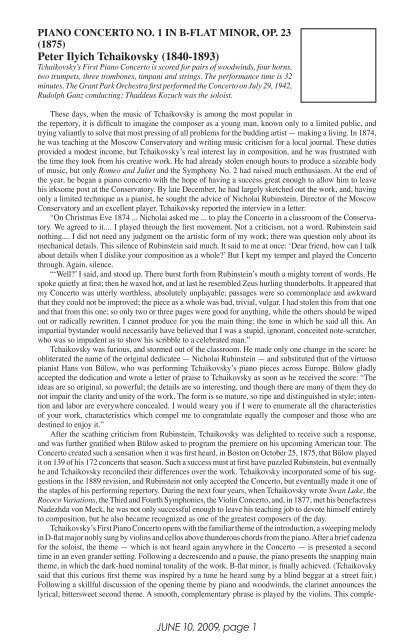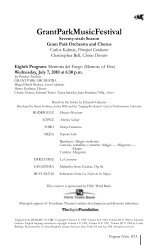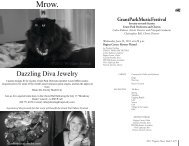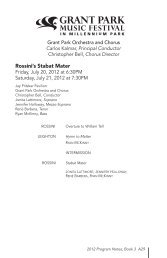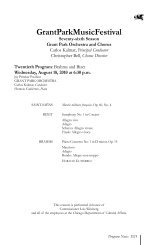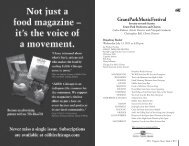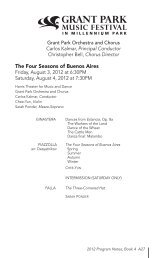Peter ilyich tchaikovsky (1840-1893) - The Grant Park Music Festival
Peter ilyich tchaikovsky (1840-1893) - The Grant Park Music Festival
Peter ilyich tchaikovsky (1840-1893) - The Grant Park Music Festival
Create successful ePaper yourself
Turn your PDF publications into a flip-book with our unique Google optimized e-Paper software.
Piano Concerto No. 1 in B-flat minor, Op. 23<br />
(1875)<br />
<strong>Peter</strong> Ilyich Tchaikovsky (<strong>1840</strong>-<strong>1893</strong>)<br />
Tchaikovsky’s First Piano Concerto is scored for pairs of woodwinds, four horns,<br />
two trumpets, three trombones, timpani and strings. <strong>The</strong> performance time is 32<br />
minutes. <strong>The</strong> <strong>Grant</strong> <strong>Park</strong> Orchestra first performed the Concerto on July 29, 1942,<br />
Rudolph Ganz conducting; Thaddeus Kozuch was the soloist.<br />
<strong>The</strong>se days, when the music of Tchaikovsky is among the most popular in<br />
the repertory, it is difficult to imagine the composer as a young man, known only to a limited public, and<br />
trying valiantly to solve that most pressing of all problems for the budding artist — making a living. In 1874,<br />
he was teaching at the Moscow Conservatory and writing music criticism for a local journal. <strong>The</strong>se duties<br />
provided a modest income, but Tchaikovsky’s real interest lay in composition, and he was frustrated with<br />
the time they took from his creative work. He had already stolen enough hours to produce a sizeable body<br />
of music, but only Romeo and Juliet and the Symphony No. 2 had raised much enthusiasm. At the end of<br />
the year, he began a piano concerto with the hope of having a success great enough to allow him to leave<br />
his irksome post at the Conservatory. By late December, he had largely sketched out the work, and, having<br />
only a limited technique as a pianist, he sought the advice of Nicholai Rubinstein, Director of the Moscow<br />
Conservatory and an excellent player. Tchaikovsky reported the interview in a letter:<br />
“On Christmas Eve 1874 ... Nicholai asked me ... to play the Concerto in a classroom of the Conservatory.<br />
We agreed to it.... I played through the first movement. Not a criticism, not a word. Rubinstein said<br />
nothing.... I did not need any judgment on the artistic form of my work; there was question only about its<br />
mechanical details. This silence of Rubinstein said much. It said to me at once: ‘Dear friend, how can I talk<br />
about details when I dislike your composition as a whole?’ But I kept my temper and played the Concerto<br />
through. Again, silence.<br />
“‘Well?’ I said, and stood up. <strong>The</strong>re burst forth from Rubinstein’s mouth a mighty torrent of words. He<br />
spoke quietly at first; then he waxed hot, and at last he resembled Zeus hurling thunderbolts. It appeared that<br />
my Concerto was utterly worthless, absolutely unplayable; passages were so commonplace and awkward<br />
that they could not be improved; the piece as a whole was bad, trivial, vulgar. I had stolen this from that one<br />
and that from this one; so only two or three pages were good for anything, while the others should be wiped<br />
out or radically rewritten. I cannot produce for you the main thing: the tone in which he said all this. An<br />
impartial bystander would necessarily have believed that I was a stupid, ignorant, conceited note-scratcher,<br />
who was so impudent as to show his scribble to a celebrated man.”<br />
Tchaikovsky was furious, and stormed out of the classroom. He made only one change in the score: he<br />
obliterated the name of the original dedicatee — Nicholai Rubinstein — and substituted that of the virtuoso<br />
pianist Hans von Bülow, who was performing Tchaikovsky’s piano pieces across Europe. Bülow gladly<br />
accepted the dedication and wrote a letter of praise to Tchaikovsky as soon as he received the score: “<strong>The</strong><br />
ideas are so original, so powerful; the details are so interesting, and though there are many of them they do<br />
not impair the clarity and unity of the work. <strong>The</strong> form is so mature, so ripe and distinguished in style; intention<br />
and labor are everywhere concealed. I would weary you if I were to enumerate all the characteristics<br />
of your work, characteristics which compel me to congratulate equally the composer and those who are<br />
destined to enjoy it.”<br />
After the scathing criticism from Rubinstein, Tchaikovsky was delighted to receive such a response,<br />
and was further gratified when Bülow asked to program the premiere on his upcoming American tour. <strong>The</strong><br />
Concerto created such a sensation when it was first heard, in Boston on October 25, 1875, that Bülow played<br />
it on 139 of his 172 concerts that season. Such a success must at first have puzzled Rubinstein, but eventually<br />
he and Tchaikovsky reconciled their differences over the work. Tchaikovsky incorporated some of his suggestions<br />
in the 1889 revision, and Rubinstein not only accepted the Concerto, but eventually made it one of<br />
the staples of his performing repertory. During the next four years, when Tchaikovsky wrote Swan Lake, the<br />
Rococo Variations, the Third and Fourth Symphonies, the Violin Concerto, and, in 1877, met his benefactress<br />
Nadezhda von Meck, he was not only successful enough to leave his teaching job to devote himself entirely<br />
to composition, but he also became recognized as one of the greatest composers of the day.<br />
Tchaikovsky’s First Piano Concerto opens with the familiar theme of the introduction, a sweeping melody<br />
in D-flat major nobly sung by violins and cellos above thunderous chords from the piano. After a brief cadenza<br />
for the soloist, the theme — which is not heard again anywhere in the Concerto — is presented a second<br />
time in an even grander setting. Following a decrescendo and a pause, the piano presents the snapping main<br />
theme, in which the dark-hued nominal tonality of the work, B-flat minor, is finally achieved. (Tchaikovsky<br />
said that this curious first theme was inspired by a tune he heard sung by a blind beggar at a street fair.)<br />
Following a skillful discussion of the opening theme by piano and woodwinds, the clarinet announces the<br />
lyrical, bittersweet second theme. A smooth, complementary phrase is played by the violins. This comple-<br />
JUNE 10, 2009, page
mentary phrase and the snapping motive from the main theme are combined in the movement’s impassioned<br />
development section. <strong>The</strong> recapitulation returns the themes of the exposition in altered settings. (<strong>The</strong> oboe<br />
is awarded the second theme here.) An energetic cadenza and a coda derived from the second theme bring<br />
this splendid movement to a rousing close.<br />
<strong>The</strong> simplicity of the second movement’s three-part structure (A-B-A) is augured by the purity of its<br />
opening — a languid melody wrapped in the silvery tones of the solo flute, accompanied by quiet, plucked<br />
chords from the strings. <strong>The</strong> piano takes over the theme, provides it with rippling decorations, and passes it on<br />
to the cellos. <strong>The</strong> center of the movement is of very different character, with a quick tempo and a swift, balletic<br />
melody. <strong>The</strong> languid theme and moonlit mood of the first section return to round out the movement.<br />
<strong>The</strong> crisp rhythmic motive presented immediately at the beginning of the finale and then spun into a<br />
complete theme by the soloist dominates much of the last movement. In the theme’s vigorous full-orchestra<br />
guise, it has much of the spirit of a robust Cossack dance. To balance the impetuous vigor of this music,<br />
Tchaikovsky introduced a contrasting theme, a romantic melody first entrusted to the violins. <strong>The</strong> dancing<br />
Cossacks repeatedly advance upon this bit of tenderness, which shows a hardy determination to dominate<br />
the movement. <strong>The</strong> two themes contend, but it is the flying Cossacks who have the last word to bring this<br />
Concerto to an exhilarating finish.<br />
Pictures at an Exhibition<br />
(1874; transcribed 1923)<br />
Modest Mussorgsky (1839-1881)<br />
Transcribed by Maurice Ravel (1875-1937)<br />
Pictures at an Exhibition, as orchestrated by Ravel, is scored for piccolo, two flutes,<br />
two oboes, English horn, two clarinets, bass clarinet, two bassoons, contrabassoon,<br />
alto saxophone, four horns, three trumpets, three trombones, tuba, timpani,<br />
percussion, two harps, celesta and strings. <strong>The</strong> performance time 35 minutes. <strong>The</strong><br />
<strong>Grant</strong> <strong>Park</strong> Orchestra first performed this work on July 8, 1953, Walter Hendl conducting.<br />
Though the history of the Russian nation extends far back into the mists of time, the country’s cultural<br />
life is of relatively recent origin. Russian interest in art, music and theater dates only from the time of <strong>Peter</strong><br />
the Great (1672-1725), the powerful monarch who coaxed his country into the modern world by importing<br />
ideas, technology and skilled practitioners from western Europe. To fuel the nation’s musical life, <strong>Peter</strong>,<br />
Catherine and their successors depended on a steady stream of well-compensated German, French and Italian<br />
artists who brought their latest tonal wares to the magnificent capital city of St. <strong>Peter</strong>sburg. This tradition<br />
of imported music continued well into the 19th century: Berlioz, for example, enjoyed greater success in<br />
Russia than he did in his native France; Verdi composed La Forza del Destino on a commission from St.<br />
<strong>Peter</strong>sburg, where it was first performed.<br />
In the years around 1850, with the spirit of nationalism sweeping across Europe, several young Russian<br />
artists banded together to rid their art of foreign influences in order to establish a distinctive nationalist character<br />
for their works. Leading this movement was a group of composers known as “<strong>The</strong> Five,” whose members<br />
included Modest Mussorgsky, Nikolai Rimsky-Korsakov, Alexander Borodin, César Cui and Mily Balakirev.<br />
Among the allies that <strong>The</strong> Five found in other fields was the artist and architect Victor Hartmann, with whom<br />
Mussorgsky became close personal friends. Hartmann’s premature death at 39 stunned the composer and<br />
the entire Russian artistic community. Vladimir Stassov, a noted critic and the journalistic champion of the<br />
Russian arts movement, organized a memorial exhibit of Hartmann’s work in February 1874, and it was<br />
under the inspiration of that showing that Mussorgsky conceived his Pictures at an Exhibition.<br />
At the time of the exhibit, Mussorgsky was engaged in preparations for the first public performance of<br />
his opera Boris Godunov, and he was unable to devote any time to his Pictures until early summer. When<br />
he took up the piece in June, he worked with unaccustomed speed. “‘Hartmann’ is bubbling over, just as<br />
Boris did,” he wrote to a friend. “Ideas, melodies come to me of their own accord, like a banquet of music<br />
— I gorge and gorge and overeat myself. I can hardly manage to put them down on paper fast enough.” <strong>The</strong><br />
movements mostly depict sketches, watercolors and architectural designs shown publicly at the Hartmann<br />
exhibit, though Mussorgsky based two or three sections on canvases that he had been shown privately by<br />
the artist before his death. <strong>The</strong> composer linked his sketches together with a musical “Promenade” in which<br />
he depicted his own rotund self shuffling — in an uneven meter — from one picture to the next. Though<br />
Mussorgsky was not given to much excitement over his own creations, he took special delight in this one.<br />
Especially in the masterful transcription for orchestra that Maurice Ravel did in 1922 for the Parisian concerts<br />
of conductor Sergei Koussevitzky, it is a work of vivid impact to which listeners and performers alike can<br />
return with undiminished pleasure.<br />
Promenade. According to Stassov, this recurring section depicts Mussorgsky “roving through the exhibition,<br />
now leisurely, now briskly in order to come close to a picture that had attracted his attention, and, at<br />
JUNE 10, 2009, page
times sadly, thinking of his friend.”<br />
<strong>The</strong> Gnome. Hartmann’s drawing is for a fantastic wooden nutcracker representing a gnome who gives<br />
off savage shrieks while he waddles about on short, bandy legs.<br />
Promenade — <strong>The</strong> Old Castle. A troubadour (represented by the saxophone) sings a doleful lament before<br />
a foreboding, ruined ancient fortress.<br />
Promenade — Tuileries. Mussorgsky’s subtitle is “Dispute of the Children after Play.” Hartmann’s picture<br />
shows a corner of the famous Parisian garden filled with nursemaids and their youthful charges.<br />
Bydlo. Hartmann’s picture depicts a rugged wagon drawn by oxen. <strong>The</strong> peasant driver sings a plaintive<br />
melody (solo tuba) heard first from afar, then close-by, before the cart passes away into the distance.<br />
Promenade — Ballet of the Chicks in <strong>The</strong>ir Shells. Hartmann’s costume design for the 1871 fantasy ballet<br />
Trilby shows dancers enclosed in enormous egg shells, with only their arms, legs and heads protruding.<br />
Samuel Goldenberg and Schmuyle. <strong>The</strong> title was given to the music by Stassov. Mussorgsky originally<br />
called this movement “Two Jews: one rich, the other poor.” It was inspired by a pair of pictures which<br />
Hartmann presented to the composer showing two residents of the Warsaw ghetto, one rich and pompous (a<br />
weighty unison for strings and winds), the other poor and complaining (muted trumpet). Mussorgsky based<br />
both themes on incantations he had heard on visits to Jewish synagogues.<br />
<strong>The</strong> Marketplace at Limoges. A lively sketch of a bustling market, with animated conversations flying<br />
among the female vendors.<br />
Catacombs, Roman Tombs. Cum Mortuis in Lingua Mortua. Hartmann’s drawing shows him being led<br />
by a guide with a lantern through cavernous underground tombs. <strong>The</strong> movement’s second section, bearing<br />
the title “With the Dead in a Dead Language,” is a mysterious transformation of the Promenade theme.<br />
<strong>The</strong> Hut on Fowl’s Legs. Hartmann’s sketch is a design for an elaborate clock suggested by Baba Yaga,<br />
the fearsome witch of Russian folklore who eats human bones she has ground into paste with her mortar<br />
and pestle. She also can fly through the air on her fantastic pestle, and Mussorgsky’s music suggests a wild,<br />
midnight ride.<br />
<strong>The</strong> Great Gate of Kiev. Mussorgsky’s grand conclusion to his suite was inspired by Hartmann’s plan<br />
for a gateway for the city of Kiev in the massive old Russian style crowned with a cupola in the shape of<br />
a Slavic warrior’s helmet. <strong>The</strong> majestic music suggests both the imposing bulk of the edifice (never built,<br />
incidentally) and a brilliant procession passing through its arches. <strong>The</strong> work ends with a heroic statement of<br />
the Promenade theme and a jubilant pealing of the great bells of the city.<br />
©2009 Dr. Richard E. Rodda<br />
JUNE 10, 2009, page
First Program: Tchaikovsky on Opening Night<br />
Wednesday, June 10, 2009 at 6:30 p.m.<br />
Jay Pritzker Pavilion<br />
<strong>Grant</strong> <strong>Park</strong> orchestra<br />
Carlos Kalmar, Conductor<br />
Stephen Hough, Piano<br />
LOGO<br />
<strong>Grant</strong><strong>Park</strong><strong>Music</strong><strong>Festival</strong><br />
Seventy-fifth Season<br />
<strong>Grant</strong> <strong>Park</strong> Orchestra and Chorus<br />
Carlos Kalmar, Principal Conductor<br />
Christopher Bell, Chorus Director<br />
SMITH<br />
arr. TOSCANINI<br />
<strong>The</strong> Star-Spangled Banner<br />
TCHAIKOVSKY Piano Concerto No. 1 in B-flat minor, Op. 23<br />
Allegro non troppo e molto maestoso —<br />
Allegro con spirito<br />
Andantino semplice — Prestissimo<br />
Allegro con fuoco<br />
Stephen Hough<br />
MUSSORGSKY<br />
arr. RAVEL<br />
Pictures at an Exhibition<br />
Promenade — <strong>The</strong> Gnome<br />
Promenade — <strong>The</strong> Old Castle<br />
Promenade — Tuileries<br />
Bydlo<br />
Promenade — Ballet of the Chicks in <strong>The</strong>ir Shells<br />
Samuel Goldenberg and Schmuyle<br />
<strong>The</strong> Marketplace at Limoges —<br />
Catacombs, Roman Tombs<br />
Cum Mortuis in Lingua Mortua<br />
<strong>The</strong> Hut on Fowl’s Legs —<br />
<strong>The</strong> Great Gate of Kiev<br />
SPONSOR:


